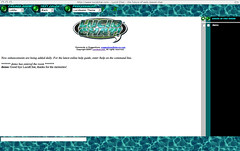
About
Lucid Chat was one of the original web-based chat products in the mid-late '90s (Web 1.0). Many of the early web-based chat rooms were very rudimentary, and either used META refreshes (remember "screen flashing"?) to update and display user's comments, Java applets, or Netscape plugins.
What made Lucid Chat unique at that time was the ability
to provide real-time text streaming through a web browser
using a simple CGI
interface. Many of the techniques used were the precursor
to what is now referred to as AJAX (Asynchronous
JavaScript and XML).
- Hidden frames to maintain state and communicate with the server
- Persistent HTTP connections
- Unbuffered CGI output
- JavaScript and DHTML
Active development on Lucid Chat stopped in 2000, and the product is no longer available for download. This page serves as a memorial to one of the first web-based chats.
History
Lucid Chat v1.0 was officially released in August 1997. However, this project had a few previous incarnations and was initially conceived back in November 1996.
TWD Chat (December 1996)

At this time I was working for an ISP and web development/hosting company called Third Wave Development. A few of my coworkers and I had started to notice that web-based chat rooms were becoming popular, and we decided to take a shot at developing our own. Our new chat software TWDChat was born, and was written in Perl & JavaScript, and used META refreshes to display user comments. This was a barebones chat room, but it was a great accomplishment given that it was done so early in the Internet revolution.
WWW Chat (March 1997)

WWWChat had some new features and an improved UI, but still used META refreshes. I was really eager to find a way to push user's comments in real-time, without the need to refresh, and without using Java or a browser plugin. I happened to find a website called EAChat (EnterActive chat) that accomplished this, and I set out on a quest to do the same!
Lucid Chat (July 1997 - November 1999)

With the help of some friends, Mountain Dew, and long hours, I was able to put together a preliminary release. This took a few months of research and hard work, and the goal was accomplished: real-time text streaming using frames (to be specific, a hidden frame) to facilitate communication, Javascript, and a nifty unix domain socket client/server model. This was finished just in time to attend the first ISPCON in August 1997 as an exhibitor with ISPWare.
In the year to come, with the help of some other developers, I eventually ported this entirely to C and released versions on Linux, Solaris, Digital Unix, and BSDi. For a period of time, Lucid Chat was sold and used on dozens of websites (a couple famous bands, record labels, movie sites, and large businesses). It was also featured in numerous reviews of chat products(most famously, ServerWatch) and compared against some of the most popular products of the day (iChat, ParaChat, ConferenceRoom, etc). Lucid Chat also continued to be listed on many free CGI/script sites and was actively downloaded and used for many years afterwards.
Lucid Chat was also briefly mentioned in an E-learning book published in 2003.
E-Learning Tools and Technologies: A consumer's guide for trainers, teachers, educators, and instructional designers

Quotes
Early on, many developers were stumped or amazed at how Lucid Chat accomplished the text streaming. One of my favorite quotes of all time is from a UseNet posting in alt.www.webmaster by CrinkleFish:
"I'm still mystified by LucidChat. It looks like the devil's handiwork to me. Tis only mark'd for hot vengeance and the rod of heaven. ;) "
Images
Here are some Lucid Chat screen shots, logos, and images:
Credits
The following people helped make Lucid Chat
possible:
Eric Blue
(Founder/Developer) - Concept, Design, Development
Doug Vogel (Developer/Artist) - Concept, Design, Development,
Artwork
Curtis Turner (ISPWare)
- Promotion, ISPCon
Koa Beam (Artist)
- Design, Artwork, Logos
Shuman
Ghosemajumder (Consultant) - Prototype
Development




